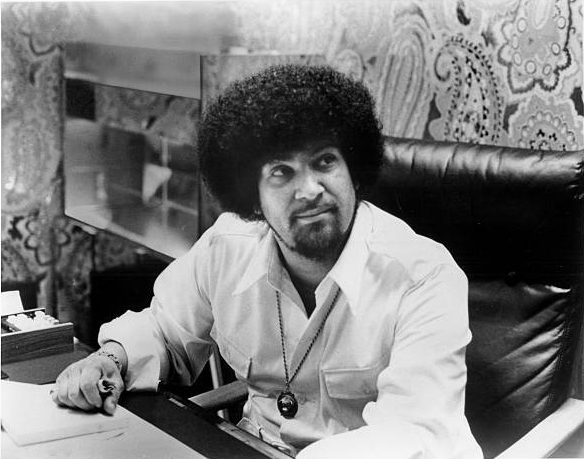Producer and songwriter Norman Whitfield revolutionized the fabled Motown Sound for a new age in music and culture, eschewing the ebullient R&B grooves that propelled the label’s commercial ascension in pursuit of something deeper, darker and more daring. Working in partnership with Motown hitmakers like the Temptations, Marvin Gaye and Edwin Starr, Whitfield drew on contemporary influences including acid rock and funk to create a series of smash singles addressing the triumphs and tragedies shaping Black identity in civil rights-era America, architecting a singularly atmospheric sound retroactively dubbed “psychedelic soul.”

Portrait (Photo by GAB Archive/Redferns)
Explore these classic singles from Whitfield’s Motown heyday to better appreciate the scope and impact of his genius.
“I Heard It Through the Grapevine” (Marvin Gaye, 1968)
With “I Heard It Through the Grapevine,” the confessional account of a man devastated to learn through the rumor mill of his lover’s infidelity, Whitfield and Marvin Gaye created what is quite possibly the greatest single in the Motown Records canon. But Gaye wasn’t even the first Motown act to record the song: Smokey Robinson’s Miracles cut “I Heard It Through the Grapevine” in August 1966, although their rendition remained unreleased for two years. Gaye’s version — recorded over a series of five studio sessions spanning from Feb. 3 to April 10, 1967 — also languished in the Motown vaults for 18 months. A fiery third rendition headlined by Gladys Knight and the Pips was the first to receive Motown founder Berry Gordy’s seal of approval, appearing on Motown’s Soul subsidiary on Sept. 28, 1967, three months after it was recorded. It became the biggest selling Motown single to date, topping Billboard’s R&B Singles chart and climbing to number two on the Pop Singles chart.

(Photo by Henry Diltz/Corbis via Getty Images)
That does not make Gaye’s version of “I Heard It Through the Grapevine” anything less than definitive, however. Its brilliance starts with Whitfield’s simmering production, which is somehow both spacious and claustrophobic at the same time, perfectly conveying the tortured psyche of a man gasping for air and grasping for terra firma as gossip swirls around him. The Funk Brothers, Motown’s crackerjack studio band, ratchet up the tension: James Jamerson’s foreboding bassline is the record’s indelible signature, of course, but Earl Van Dyke’s funereal Wurlitzer and Richard “Pistol” Allen’s warlike tom toms are no less essential to the underlying melancholy and menace. (The same goes for Jack Ashford’s tambourine, which slithers like a rattlesnake winding through the Garden of Eden.) Paul Riser’s string arrangement is another marvel: the punctuations of the Detroit Symphony Orchestra serve notice that “I Heard It Through the Grapevine” is an altogether different kind of Motown record, one that is more sophisticated — more frankly adult — than anything the label had previously attempted.
When Motown officially released “I Heard It Through the Grapevine” on Oct. 30, 1968, Gaye’s rendition outsold Knight’s, topping the Billboard Pop Singles chart for seven consecutive weeks on its way to becoming Motown’s best-selling single yet.
“I Can’t Get Next to You” (The Temptations, 1969)
Many of Whitfield’s most celebrated and ambitious productions are headlined by Motown’s premier male vocal group, the Temptations. “I Can’t Get Next to You” is on paper a relatively conventional effort — its clever, colorful spin on unrequited romance would have sailed through Motown’s quality control tribunal at any time in the label’s long history — but Whitfield’s audacious production is a different matter altogether.

(Photo by Walter Iooss Jr./Getty Images) *** Local Caption ***
“I Can’t Get Next to You” begins with the sound of applause (later sampled in another Whitfield-produced Temptations hit, “Psychedelic Shack”) before vocalist Dennis Edwards hushes the audience, entreating them (and us) to “Hold it, hold it, listen.” A bit of late-night barroom piano immediately follows… and then, the Funk Brothers absolutely erupt. Blasts of brass make way for a dazzlingly complex web of percussion dominated by Dennis Coffey’s metronomic, chicken-scratch guitar. As for the Tempts themselves, they’ve never sounded so fierce or so focused: the song’s round-robin lead vocal approach vividly spotlights the extraordinary range of their individual voices, ping-ponging from the depths of Paul Williams’ baritone to the preposterous heights of Eddie Kendricks’ falsetto.
“I Can’t Get Next to You” was the product of no fewer than six recording sessions between June 23 and July 3, 1969. “I would just devote my time to making sure I got the hit,” Whitfield told BBC Radio 1’s Stuart Grundy for the broadcaster’s 1984 documentary The Story of Motown. “I could always fill the album with different types of songs and stuff, but that hit record was the key. It was the vehicle in terms of selling the album, and selling the act.” The results speak for themselves: “I Can’t Get Next to You” vaulted the Temptations back to the top of the Billboard Pop Singles chart for the first time since “My Girl” four years earlier.
“Just My Imagination (Running Away with Me)” (The Temptations, 1971)
In the midst of tough-minded, socially conscious psychedelic soul classics like “Cloud Nine,” “Ball of Confusion (That’s What the World Is Today)” and “Papa Was a Rollin’ Stone,” Whitfield cannily steered the Temptations back to the group’s bread and butter: the lush romantic ballad. “Just My Imagination (Running Away with Me),” their third chart-topping pop hit, is no retread, however. Only Whitfield could have produced a song so emotionally weighty and so musically weightless: its celestial orchestral arrangement shimmers and sighs, elevating the everyday pathos of unrequited longing into the realm of sugar-spun fantasy.

(Photo by Chicago Sun-Times Collection/Chicago History Museum/Getty Images)
The Temptations’ Eddie Kendricks contended in a 1991 interview that by the time “Just My Imagination” materialized, “the fans were screaming bloody murder” over Whitfield’s studio excesses and demanding a return “to what we do best.” Moreover, Kendricks and leader Otis Williams were no longer on speaking terms (Kendricks left the group soon after to mount a solo career) and co-founder Paul Williams — the Tempts’ original lead singer — was battling both alcoholism and sickle-cell anemia, which ravaged his voice and hastened his own exit from the ranks in spring 1971.
None of that rancor and regret bleeds into “Just My Imagination (Running Away with Me),” however. This profoundly existential soul record is too tender — too humane — for that. Its narrator is a lovelorn man in thrall to a woman who passes his window each day, and he dreams of the life they might someday share (“A cozy little home out in the country with two children, maybe three”). Reality inevitably pulls him out of his reverie: they’ve never even met, and she doesn’t know he exists. Credit the Temptations for making this material neither mawkish nor melodramatic; despite the behind-the-scenes drama, their harmonies were never more beautiful or more unified, and Kendricks’ heartrending falsetto is sublime.
Motown released “Just My Imagination (Running Away with Me)” in January 1971. The second single issued from the Temptations’ Sky’s the Limit album, it ultimately spent two weeks at number one on the Billboard Pop Singles chart and three weeks atop the R&B Singles chart.






